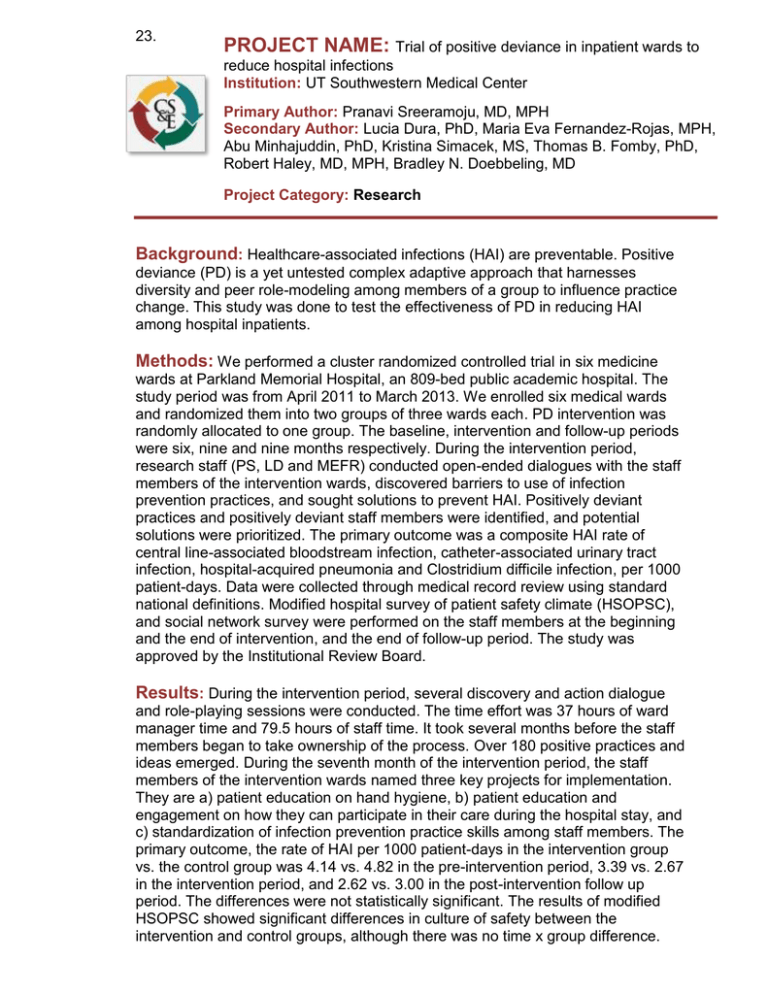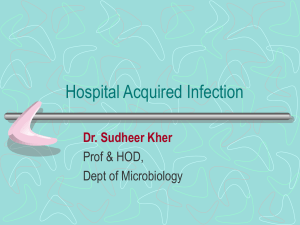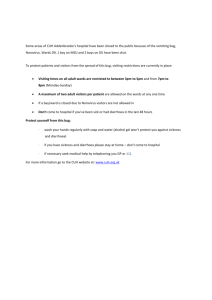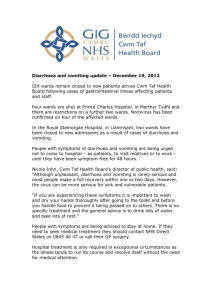Trial of positive deviance in inpatient wards to reduce hospital infections
advertisement

23. PROJECT NAME: Trial of positive deviance in inpatient wards to reduce hospital infections Institution: UT Southwestern Medical Center Primary Author: Pranavi Sreeramoju, MD, MPH Secondary Author: Lucia Dura, PhD, Maria Eva Fernandez-Rojas, MPH, Abu Minhajuddin, PhD, Kristina Simacek, MS, Thomas B. Fomby, PhD, Robert Haley, MD, MPH, Bradley N. Doebbeling, MD Project Category: Research Background: Healthcare-associated infections (HAI) are preventable. Positive deviance (PD) is a yet untested complex adaptive approach that harnesses diversity and peer role-modeling among members of a group to influence practice change. This study was done to test the effectiveness of PD in reducing HAI among hospital inpatients. Methods: We performed a cluster randomized controlled trial in six medicine wards at Parkland Memorial Hospital, an 809-bed public academic hospital. The study period was from April 2011 to March 2013. We enrolled six medical wards and randomized them into two groups of three wards each. PD intervention was randomly allocated to one group. The baseline, intervention and follow-up periods were six, nine and nine months respectively. During the intervention period, research staff (PS, LD and MEFR) conducted open-ended dialogues with the staff members of the intervention wards, discovered barriers to use of infection prevention practices, and sought solutions to prevent HAI. Positively deviant practices and positively deviant staff members were identified, and potential solutions were prioritized. The primary outcome was a composite HAI rate of central line-associated bloodstream infection, catheter-associated urinary tract infection, hospital-acquired pneumonia and Clostridium difficile infection, per 1000 patient-days. Data were collected through medical record review using standard national definitions. Modified hospital survey of patient safety climate (HSOPSC), and social network survey were performed on the staff members at the beginning and the end of intervention, and the end of follow-up period. The study was approved by the Institutional Review Board. Results: During the intervention period, several discovery and action dialogue and role-playing sessions were conducted. The time effort was 37 hours of ward manager time and 79.5 hours of staff time. It took several months before the staff members began to take ownership of the process. Over 180 positive practices and ideas emerged. During the seventh month of the intervention period, the staff members of the intervention wards named three key projects for implementation. They are a) patient education on hand hygiene, b) patient education and engagement on how they can participate in their care during the hospital stay, and c) standardization of infection prevention practice skills among staff members. The primary outcome, the rate of HAI per 1000 patient-days in the intervention group vs. the control group was 4.14 vs. 4.82 in the pre-intervention period, 3.39 vs. 2.67 in the intervention period, and 2.62 vs. 3.00 in the post-intervention follow up period. The differences were not statistically significant. The results of modified HSOPSC showed significant differences in culture of safety between the intervention and control groups, although there was no time x group difference. Social network analysis revealed that the average number of relationships per staff member decreased to a greater extent in the control group compared to the intervention group. During the intervention and follow-up periods, the six study wards experienced an average turnover of 53%. Conclusions: Positive deviance intervention in inpatient medicine wards to reduce HAI was not effective when implemented for a nine-month period when the wards were experiencing a high staff turnover.




